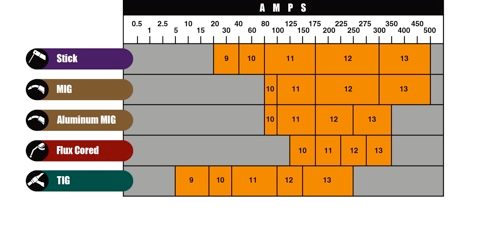As Halloween nears, ghouls and ghost slink out of their graves and clowns with bright red hair haunt our sewers. Our imaginations become a weird wonderland of terror. But the most real fears aren’t just in our minds. Here’s the top real world fears welders deal with every day and how to keep yourself safe from them.
Losing an Eye (Or Two)
There’s a reason our eyes are these 2 tiny spheres hidden high up in our skulls where wild animals and children have a hard time reaching them: They’re incredibly delicate. To put it in perspective, a cubic inch of bone can bear several tons of weight (in principle, don’t try at home). An eyeball can’t take more than a few pounds. That’s why welders have good reason to be concerned about their peepers.
Most immediate damage to eyeballs comes from using crappy eye protection or none at all. If you forgot your helmet, don’t try closing your eyes every time you strike an arc. Your skin flaps aren’t enough protection to keep harmful rays from hitting your eyeballs.
The vast majority of welders are smart about avoiding the immediate effects of welding. However, not enough of us think about the long term. For instance, during welding, iron oxides are released into the air. After several years of welding in unventilated areas, these iron oxides can build up in your eyes, creating a condition called Siderosis. Hopefully the picture to the left is enough to help you to remember to always weld in ventilated areas. If you can’t ventilate your area, you might want to check out some headgear with a PAPR system or even a fume extractor.
Electrocution
Most human beings have a natural fear of being struck by lightning. But someone forgot to tell that to welders. We play with lightning all day long. And while most welders have a fair amount of control over their arc (see our post on welding while intoxicated here), there’s still a certain level of danger involved. The major cause of electrocution while welding is from improperly maintained equipment or using your machine incorrectly (e.g. welding in a puddle of water without the right equipment).
Maintaining your equipment to avoid being zap-fried is easier than you might think. Dust plays a huge role in damaging machines. Placing a cover over your equipment is a simple way to largely reduce this problem. If you believe your machine is beginning to malfunction, just take it in. Too many welders use phrases like, “Yeah, it’s sparking but as long as I don’t touch it…”
Catching Fire
Here’s a terrorizing fact we could only share during Halloween: Fire generally doesn’t kill. Instead, it consumes the air around someone, making it impossible to breathe. While both plasma and arc welding don’t actually use open flames like other welding processes do, they can still cause fires or burns if used incorrectly. In fact, burns are still the most common injury in welding today.
Sadly, most of these accidents could be avoided with a little preparation. For instance, welding without gloves is just not a good idea. If you’re going to be doing an overhead weld, make sure you’ve got full face, arm and body protection. Finally, if you’re welding near explosive or flammable material, you might consider moving it away from you.
Welding has very few “freak accidents.” If you’re doing what you’re supposed to with equipment that’s functioning correctly, you’ve got nothing to worry about. With that in mind, if you have any questions about your machine, please give us a call (even if you didn’t buy it from us). We’ve got the best technical team in the industry with a hive mind of experience and knowledge to pull from.
Tell us some of your biggest welding fears in the comments section below and make sure to check out our post on our top 5 DIY Halloween projects!










